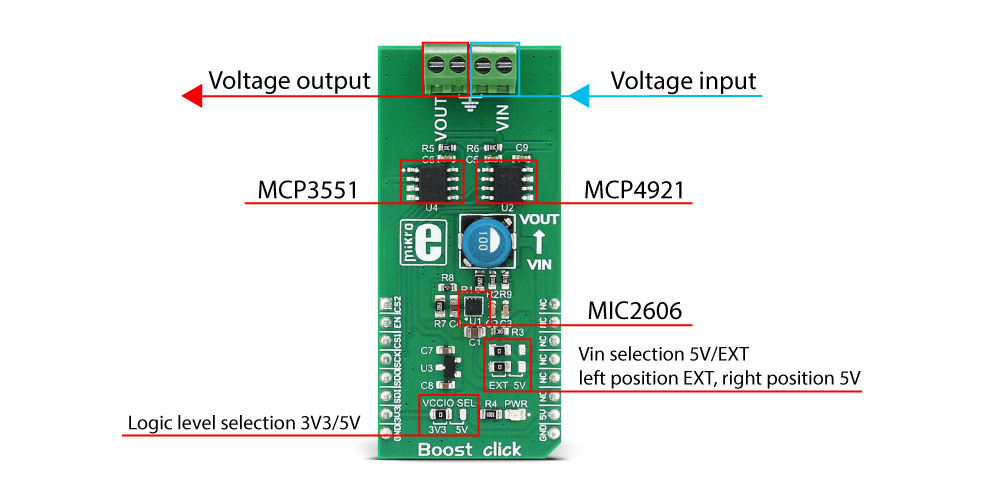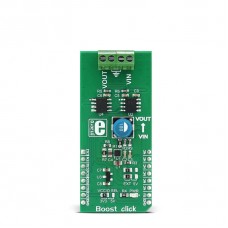Boost click
Boost click carries Microchip’s MIC2606, a 2MHz, PWM DC/DC boost switching regulator available in a 2mm x 2mm MLF® package.
Boost click provides an adjustable output voltage through the onboard DAC that drives the FB pin of the MIC2606 to set desired output voltage. The click also has an onboard ADC that converts output voltage and sends its digital value through SPI pins of mikroBUS™ to the microcontroller. The input voltage can be set to 5V from mikroBUS™ or in range 7-20V from an external DC source connected to VIN screw terminal. The output voltage can be set up to 38V.
Note: If the user wants to connect external voltage to VIN, then the click needs the power supply unit connected to the VIN screw terminal.
How the click works
As you can see from the image there are two onboard screw terminals. One is for connecting the external VIN and the other is for connecting the load. The microcontrollerf reads the output voltage through the SPI from the onboard ADC and according to the desired output voltage, sends calculated data through SPI to an onboard DAC.
The DAC drives the FB pin of the MIC2606 to set desired output voltage. The output voltage must always be set greater than the input voltage, otherwise, performance is not guaranteed. Instead of connecting external VIN it is possible to use 5V from mikroBUS. This is done by changing the positions of two onboard jumpers from position EXT to position 5V.
Note: Both of them must be in position 5V, otherwise performance is not guaranteed.
Boost click features
MIC2606 is a 0.5A, 2MHz Wide Input Range Boost Regulator with Integrated Switch and Schottky Diode. It’s FB (feedback) pin provides the control path to control the output. This FB pin is driven by an onboard DAC – MCP4921. This is a 2.7 – 5.5V, low-power, low DNL, 12-Bit Digital-to-Analog Converter (DAC) with SPI interface. It provides high accuracy and low noise performance for industrial applications. The output voltage is connected to an onboard ADC - MCP3551 - through a voltage divider. MCP3551 is a 2.7V to 5.5V low-power, 22-bit Delta-Sigma Analog-to-Digital Converter.

The reference voltage for both the ADC and DAC is provided by MAX6106 – onboard voltage reference.
Specifications
| Type | Boost |
| Applications | Any applications where it is necessary to step up the voltage |
| On-board modules | MIC2606, MCP3551, MCP4921 |
| Interface | SPI |
| Input Voltage | 3.3V or 5V |
| Click board size | L (57.15 x 25.4 mm) |
Pinout diagram
This table shows how the pinout on Boost click corresponds to the pinout on the mikroBUS™ socket (the latter shown in the two middle columns).
Jumpers and settings
| Designator | Name | Default Position | Default Option | Description |
|---|---|---|---|---|
| JP1 | VCCIO SEL | Left | 3V3 | Logic level selection 3V3/5V, left position 3V3, right position 5V |
| JP2 | VIN SEL | Left | EXT | Vin selection 5V/EXT, left position EXT, right position 5V |
| JP3 | VIN SEL | Left | EXT | Vin selection 5V/EXT, left position EXT, right position 5V |
JP1 - this jumper allows you to select the logic level voltage for the communication lines. It can be 3.3V or 5V and must be paired with the supply voltage of the host microcontroller.
JP2 and JP3 - these jumpers serve to select the input voltage of the MIC2606. Both jumpers must always be in the same position and move simultaneously. If they are in the left position, (EXT) then the input voltage is taken from the connector VIN, if they are in the right position, (5V) then the input voltage is taken from the mikroBUS™ and it is 5V.
Maximum ratings
| Description | Min | Typ | Max | Unit |
|---|---|---|---|---|
| VIN | 7(1) | ... | 20(1) | V |
| 5(2) | ||||
| VOUT | 15(1) | ... | 38 | V |
| 12(2) | ... | 38 |
(1) If external supply is connected
(2) If VIN is 5V from mikroBUS
Software Support
We provide a library for the Boost click on our LibStock page, as well as a demo application (example), developed using MikroElektronika compilers. The demo application can run on all the main MikroElektronika development boards.
Note: depending on the development board you are using, you may need the RS232 click or USB-UART click or USB UART 2 click, to connect to your PC. The terminal available in all Mikroelektronika compilers, or any other terminal application of your choice, can be used to read the message.Library Description
The library carries two functions alongside with the driver init function. These functions are enough to have complete control over Boost click.
Key functions
void boost_setState( uint8_t state ) - Turn ON/ Turn OFF the MIC2606void boost_setVoltage( uint16_t millivolts ) - Set desired voltage on output
The accuracy of the function that sets the output voltage is approximately +/- 3%.
Demo application description
The application is composed of three sections:
- System Initialization - Initializes the GPIO and SPI but also the UART, which will be used for information logging.
- Application Initialization - Driver initialization by providing appropriate function pointers.
- Application Task - (code snippet) Periodically increases and decreases voltage in a range between 15 and 30 Volts. Information about the current operation is logged to UART.
Code snippet
void applicationTask()
{
UART1_Write_Text( "rnSetting voltage to 15000rn" );
boost_setVoltage( 15000 );
Delay_ms( 3000 );
UART1_Write_Text( "rn----------------------------------------------rn" );
UART1_Write_Text( "rnSetting voltage to 30000rn" );
boost_setVoltage( 30000 );
Delay_ms( 3000 );
UART1_Write_Text( "rn----------------------------------------------rn" );
}
The example also carries additional functions for the GPIO control which are provided during driver initialization. These functions are necessary and the implementation depends on the type of development system which is used.
Other mikroE Libraries used in the example:
- UART
Downloads
mikroBUS™ Standard specificationEnter the code in the box below:


















